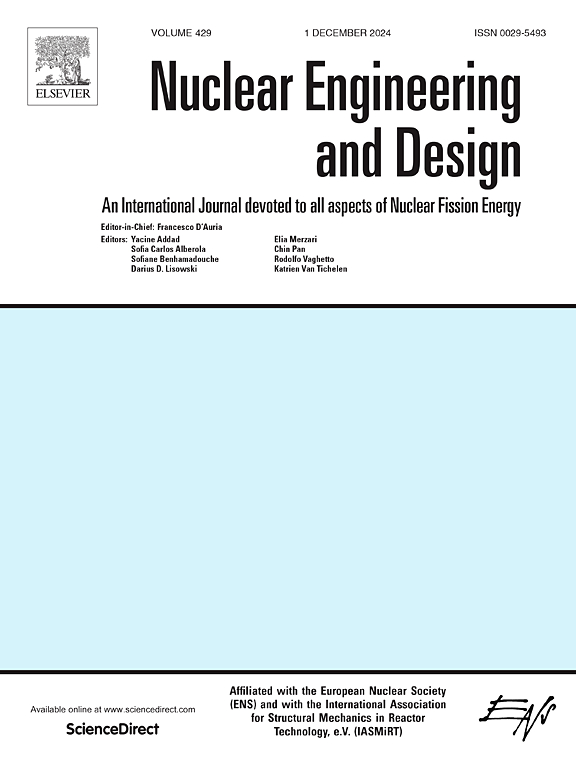Comparison of neutronics performance of various TRISO fuels
IF 1.9
3区 工程技术
Q1 NUCLEAR SCIENCE & TECHNOLOGY
引用次数: 0
Abstract
TRISO (Tristructural Isotropic) particle fuel is a type of advanced nuclear fuel developed for High-Temperature Gas-Cooled Reactors (HTGRs). Its robust containment properties make TRISO particle fuel a promising candidate for Accident-Tolerant Fuels (ATFs) for next-generation reactors. In this study, the physics model of HTTR was established with the Monte Carlo code MCNP6.2 to evaluate the neutronic properties when utilizing various TRISO form fuels in High-Temperature Test Reactor (HTTR). The fuels considered in this study include UO2, UC, and UN embedded in the core of TRISO particles. Moreover, the UC fuel is coated with TiN (UC_TiN), while the UN fuel is coated with ZrC (UN_ZrC). These two fuel types have been recognized as having manufacturing prospects, so ascertaining the effects of these coating materials on their neutronic performance before conducting practical applications is necessary. The results indicate that the isothermal temperature coefficients of the UC and UN fuels remained negative during the experimental operation, particularly −0.022 to −0.032 lower than the UO2_TRISO fuel in the operational temperature, −0.016 to −0.043 lower in the condition when it exceeded the temperature of operational condition, shows the safety aspect of the utilization of ATFs. The effective multiplication factor of each fuel remained nearly constant during 660 EFPD; each fuel, accounting for the initial drop, has a indicating that the fuel replacement that occurred during the operation procedure maintained stability. Moreover, the neutron spectrum at the Beginning of Cycle (BOC) and End of Cycle (EOC) showed that the significant difference in the effective multiplication factor of UC_TRISO and UC_TiN was caused by the coating layers. The moderator-to-fuel ratio provides evidence that the difference between the fuels was caused by the fuel design instead of operational conditions, indicating that the heavy metal coating might not be suitable for HTGRs compared to TRISO coating. The spent fuel analysis is discussed to clarify fuel variations, which shows that the minor actinides of each fuel have increased about 4.2 %–27.7 % in comparison with the UO2_TRISO, based on these neutronic mechanisms and calculation analysis, thus providing compelling evidence supporting the feasibility of applying ATFs in HTGRs.
求助全文
约1分钟内获得全文
求助全文
来源期刊

Nuclear Engineering and Design
工程技术-核科学技术
CiteScore
3.40
自引率
11.80%
发文量
377
审稿时长
5 months
期刊介绍:
Nuclear Engineering and Design covers the wide range of disciplines involved in the engineering, design, safety and construction of nuclear fission reactors. The Editors welcome papers both on applied and innovative aspects and developments in nuclear science and technology.
Fundamentals of Reactor Design include:
• Thermal-Hydraulics and Core Physics
• Safety Analysis, Risk Assessment (PSA)
• Structural and Mechanical Engineering
• Materials Science
• Fuel Behavior and Design
• Structural Plant Design
• Engineering of Reactor Components
• Experiments
Aspects beyond fundamentals of Reactor Design covered:
• Accident Mitigation Measures
• Reactor Control Systems
• Licensing Issues
• Safeguard Engineering
• Economy of Plants
• Reprocessing / Waste Disposal
• Applications of Nuclear Energy
• Maintenance
• Decommissioning
Papers on new reactor ideas and developments (Generation IV reactors) such as inherently safe modular HTRs, High Performance LWRs/HWRs and LMFBs/GFR will be considered; Actinide Burners, Accelerator Driven Systems, Energy Amplifiers and other special designs of power and research reactors and their applications are also encouraged.
 求助内容:
求助内容: 应助结果提醒方式:
应助结果提醒方式:


